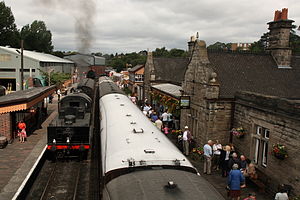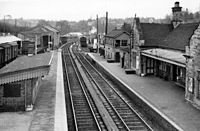Difference between revisions of "Bridgnorth"
m (tweak headings) |
m (add links) |
||
| Line 6: | Line 6: | ||
! Up (towards [[Kidderminster]]) !! Down (towards [[Shrewsbury]]) | ! Up (towards [[Kidderminster]]) !! Down (towards [[Shrewsbury]]) | ||
|- | |- | ||
| − | | [[Hampton Loade]] (4½ miles) || | + | | [[Hampton Loade]] (4½ miles)<br>via [[Eardington]] || Present day: line terminates.<br>Pre closure: [[Linley]] |
|- | |- | ||
|} | |} | ||
Revision as of 16:47, 13 August 2015
| UpIn reference to the direction of travel means towards the major terminus (i.e. towards Kidderminster on the present day SVR) (towards Kidderminster) | DownIn reference to the direction of travel means away from the major terminus (i.e. towards Bridgnorth on the present day SVR) (towards Shrewsbury) |
|---|---|
| Hampton Loade (4½ miles) via Eardington |
Present day: line terminates. Pre closure: Linley |
The station
Bridgnorth is the current Northern terminus of the SVRSevern Valley Railway. It has two platforms, a yard, and a signal box. The original Severn Valley Railway continued northwards towards Ironbridge through a 550 yard long tunnel underneath Bridgnorth High Town. From time to time the possibility of re-opening the section of the line north of Bridgnorth is raised on discussion forums and elsewhere. The official stance of the SVRSevern Valley Railway varies somewhat confusingly between "maintaining a watching brief" and "the railway land north of Bridgnorth has been long since sold, and there is now no possibility of Severn Valley trains reaching Ironbridge and Shrewsbury ever again".
Bridgnorth is home to the SVR Loco Works. Bridgnorth MPDMotive Power Depot (motive power department) is the principal base for the Railway's locomotives. Bridgnorth is also home to two new build projects, BRBritish Rail or British Railways Class 3 locomotive 82045 and a replica of the Trevithick locomotive Catch Me Who Can.
Day to day restoration and maintenance is carried out by a group going by the name of 'The Wailing Wall Construction Company plc (pretty limited craftsmen)'. The Bridgnorth site is presently the subject of development proposals that will see, most notably, the removal of the Portacabin style Refreshment room and replacement with a early 20th century Great Western style building which will be located to the south of the existing Jacobean style station building. Other features of the current proposals include replacement volunteer accommodation, replacement/enlarged water tank and improved car parking facilities.
Facilities
Bridgnorth has a pay and display car park, with overflow parking available a short walk away. Other facilities for visitors include a buffet, a gift shop and 'The Railwayman’s Arms' pub. High Town, with its Castle Gardens and Cliff Railway, can be accessed from the SVRSevern Valley Railway via a footbridge outside the entrance to the Station building.
A lineside public viewing area is situated at the foot of Pan Pudding Hill, on the opposite side of the line from Platform 1. This can normally be accessed by taking the steps down from the car park near the Railwayman's Arms pub (the 'Donkey Gallops') and going through the Engine Shed Underpass. A flight of steps on the right then leads up to the viewing area. When access is allowed to the Bridgnorth Works (normally only during Gala events), access to the viewing area is possible direct from the south end of Platform 2.
Points of interest
Footbridge outside Bridgnorth Station
This view from Bridgnorth Station shows the footbridge connecting the station to New Road. The original footbridge at this location was built by Rubery Owen & Co. Ltd. in 1895, but was deemed beyond repair and demolished by Bridgnorth Council in 1976. It can be seen in photographs 8 and 9 in the gallery of Sellick photographs below. The new footbridge, which was built under the auspices of the Bridgnorth Footbridge Trust, was opened in July 1994. The War Memorial in Bridgnorth High Town’s Castle Gardens can also be seen.
Platform 1
Platform 1 originally ended by the water tower, as can be seen in photographs 8 and 9 in the gallery of Sellick photographs below. An extension was added in 1981 using materials recovered from the ex-GWRGreat Western Railway goods shed at Cradley. There is a noticeable change in the appearance of the platform at that point, which can be seen in this photograph.
The Railwayman's Arms
Bridgnorth Station building includes a licensed public bar, The Railwayman’s Arms. This remained open when the station was closed by BRBritish Rail or British Railways in September 1963 - the group of potential preservationists who visited Bridgnorth in July 1965 were challenged by George Thorpe who ran it at the time.
The pub sign on the platform features a painting of Ivatt ‘Mickey Mouse’ 46443.
Pan Pudding Hill
Pan Pudding Hill, or sometimes Panpudding Hill, is a scheduled ancient monument which overlooks Bridgnorth station. The man-made hill was built in 1102, on the orders of King Henry I, as a siege earthwork to attack and capture Bridgnorth Castle. The distance from the hill to the castle, nearly 300 yards, is a testament to the power of mediaeval siege catapults.
Pan Pudding Hill was used to attack Bridgnorth Castle on other occasions, and finally in 1646 by Cromwell’s Parliamentarians during the English Civil War. After the last attack Bridgnorth Castle was blown up, leaving only the remains of the keep which can be seen in the castle grounds in High Town.[1]
Bridgnorth history before preservation
- 1862: When the original Severn Valley Railway opened, Bridgnorth Station is the principal intermediate station and crossing point between Hartlebury and Shrewsbury. The station building is made of stone in a Jacobean architectural style.
- 1887: The down platform is extended, a passenger shelter is erected, and a cast-iron and wrought-iron lattice footbridge is built to connect it to the up platform.
- 1887: The Town Corporation pays for a new approach road to the station.
- 1892: Two fully interlocked signalboxes open at the north and south ends of the station, replaced in 1923 by a single central box on the up platform.
- 1895: The Town Corporation pays for a lattice footbridge to shorten the route from High Town to the railway, at a cost of £1,400.
- 1922: Knowle Sand Brick Works siding opens, with ground frames at either end of loop, capable of accommodating 35 standard wagons plus engine and brake van.
- 1962: Bridgnorth Town Council objects to BRBritish Rail or British Railways's proposals to withdraw passenger trains between Shrewsbury and Bewdley, believing the line could be promoted as a holiday attraction.
- 1963: Official notice is given of the withdrawal of passenger services north of Bewdley, to be effective from 9 September 1963. Freight and parcels will continue until the end of the year, after which time only coal traffic from the south to and from Alveley Colliery will use the line. The last BRBritish Rail or British Railways passenger service to run into Bridgnorth from the south is on 8 September 1963, double headed by ex-GWRGreat Western Railway 0-6-0 Pannier Tanks Nos 9624 and 4665.
At the end of 1963 Bridgnorth and all the other Severn Valley line stations except Bewdley and Stourport are closed completely, and the track is taken up between Bridgnorth and Buildwas.[2]
Gallery
1) Ex-GWRGreat Western Railway Small PrairieLocomotive with a 2-6-2 wheel configuration 5538 calls at Bridgnorth in April 1957 (Sellick Collection)
2) A steam-hauled service and an ex-GWRGreat Western Railway Diesel Railcar pass at Bridgnorth in August 1962 (Sellick Collection)
3) An ex-GWRGreat Western Railway Diesel Railcar passes a Northbound train at Bridgnorth in September 1962 (Sellick Collection)
4) The pre-preservation signal box and a Northbound train in September 1962 (Sellick Collection)
5) Ex-LMSLondon Midland & Scottish Railway IvattHenry George Ivatt, Chief Mechanical Engineer (CME) of the London, Midland and Scottish Railway 1946-1948. CME of BR (London Midland Region) 1948-1951 Tank 41202 passes a BRBritish Rail or British Railways DMUDiesel Multiple Unit at Bridgnorth in October 1962 (Sellick Collection)
6) 80072 stands at Bridgnorth in snowy conditions on 12 January 1963 (Sellick Collection)
7) 80072 departs Bridgnorth. Note the van included in the train (Sellick Collection)
8) Ex-GWRGreat Western Railway Pannier 3619 takes water at Bridgnorth in January 1963 (Sellick Collection)
9) A view of the station and high town from Pan Pudding Hill in January 1963 (Sellick Collection)
10) An ex-LMSLondon Midland & Scottish Railway locomotive calls at Bridgnorth on 31 July 1963, shortly before the closure of the line (Sellick Collection)
11) GWRGreat Western Railway Panniers 9624 and 4665 prepare to depart Bridgnorth with the last BRBritish Rail or British Railways train on 8 September 1963 (Sellick Collection)
References
- ↑ shropshirehistory.org.uk Retrieved 26 May 2015.
- ↑ Information from the Bridgnorth Station website

















